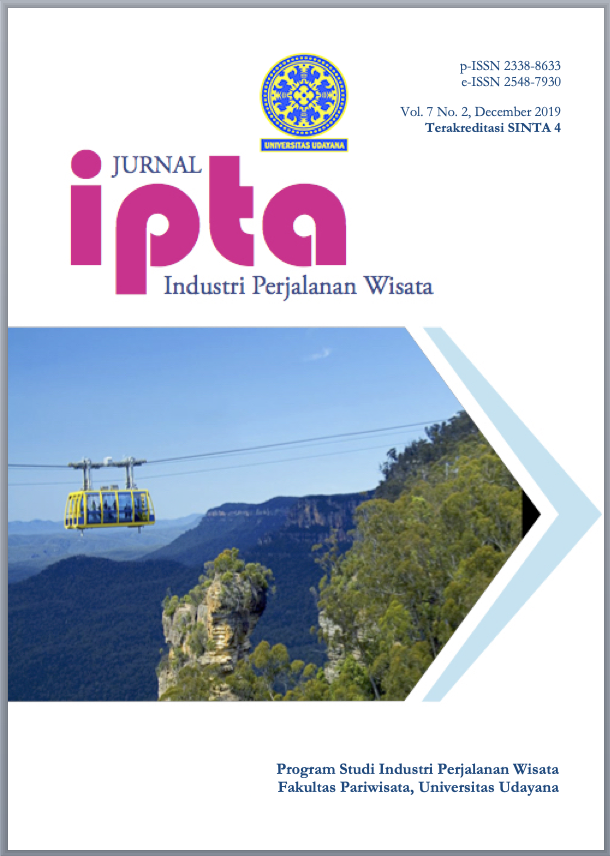SINERGITAS PENTAHELIX DALAM PEMULIHAN PARIWISATA PASCA BENCANA ERUPSI GUNUNG API SINABUNG DI KABUPATEN KARO, SUMATERA UTARA
Abstract
The eruption of Mount Sinabung had a pretty heavy impact on Karo District, in terms of the tourism economy sector, which has been the signature economy motor of this region. For almost 1 (one) decade, the eruption disaster shook, the recovery effort is still stagnant despite various government efforts. Therefore, this study aims to carry out an inventory of economic recovery, particularly in the tourism sector in Karo District by including the pentahelix synergy model as a surefire strategy to encourage community independence and achieve faster and more sustainable recovery goals. This study uses qualitative research methods with the main data collection techniques through a Focus Group Discussion. The results achieved indicate several strategies can be carried out to restore tourism in Karo District, including: rehabilitation of the image of Karo district as a safe tourist destination, strengthening the disaster awareness movement, infrastructure recovery, to the creation of signature tourism products based on disaster tourism, health tourism and agro tourism. This study also illustrates what roles can be taken by the government, academia, industry, society and the media in each strategy and proposed program.
Downloads
References
BNPB. (2017). Laporan Kinerja Badan Nasional Penanggulangan Bencana.
BNPB. (2019). Sinergitas Pentahelix Dalam Mitigasi Bencana. Diakses dari https://bnpb.go.id/sinergitas-pentahelix-dalam-mitigasi-bencana
Bovy, M. B. & Lawson, F. R., (1998). Tourism and Reaction HandBook of Planning and Design. London: The Architectural Press.
Butler, R.W. (1980). The Concept of a Tourist Area Cycle of Evolution: Implications for Management of Resources. The Canadian Geographer, 24 (1), 5-12.
Edward, I. (1991). Tourism Planning and Sustainable Development Approach. New York: Van Nostrand Reinblod.
Febriaty, H. (2015). Dampak Erupsi Gunung Sinabung terhadap Pendapatan dari Sektor Pariwisata di Kabupaten Karo. Jurnal Ekonomikawan, 15(1).
Jahid, Jamaludin (2019). Destinasi Wisata: Butuh Sinergi dan {eran Penta Helix. Diakses dari: https://fajar.co.id/2019/06/17/destinasi-wisata-butuh-sinergi-dan-peran-penta-helix/amp
Leask, Anna. (2016). Visitor Attraction Management: A Critical Review of Research 2009-2014. Journal of Tourism Management Vol. 57, p. 335-361.
Maulana, A. (2019). Pemetaan Prospek Pasar Wisatawan Nusantara di Indonesia. Jurnal Kepariwisataan Indonesia: Jurnal Penelitian dan Pengembangan Kepariwisataan Indonesia, 13(1), 1-15. Retrieved from http://ejournal.kemenpar.go.id/index.php/jki/article/view/58
Middleton, et al. (2009). Marketing Travel and Tourism. Fourth Edition, Elsevier.
Miles, M.B., Huberman, A.M. and Saldana, J. (2014). Qualitative Data Analysis: A Methods Sourcebook. Sage, London.
Miless, M. H. (2014). Qualitative Data Abalysis, A Methods Sourcebook, Edition 2. USA: Sage Publications.
Miranda, Eduardo. (2011). Time Boxing Planning: Buffered Moscow Rules. ACM SIGSOFT Software Engineering Notes. DOI: 10.1145/2047414.2047428
Raju. (2000). Tourism Marketing and Management. 1st edition, Manglam Publications.
Robustin, T. P., Andi, R., Suroso, I., & Yulisetiarini, D. (2018). The Contribution of Tourist Attraction, Accessibility and Amenities in Creating Tourist Loyalty in Indonesia. J. Bus. Econ. Review, 3(4), 92-98.
Smith, S. L. (2011). Tourism Analysis a Hardbook. Logman Scientific and Technical.
Suwontoro, Gamal (2001). Dasar-dasar Pariwisata. Penerbit Andi, Yogyakarta.
Swarbrooke. (1996). Pengembangan Pariwisata. Jakarta: Gramedia Pustaka Utama.
Undang-undang No. 10 Tahun 2009. Kepariwisataan.
Weafer, D. & Lawton, L. (2010). Tourism Managment: Third Edition. Singapore: John Wiley & Sons Australia, Ltd.
Yoeti, Oka A. (1997). Perencanaan dan Pengembangan Pariwisata. Jakarta: PT. Pradnya Paramita.
_______ (2008). Marketing Tourism. PT. Pradnya Paramitha, Jakarta.





